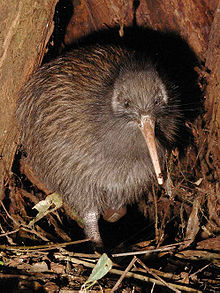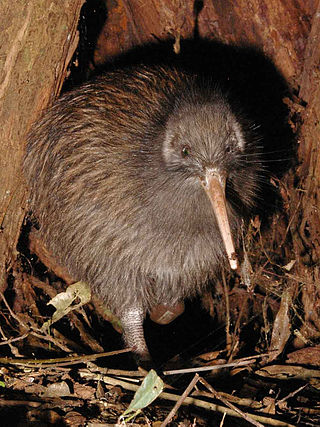
Kiwi are flightless birds endemic to New Zealand of the order Apterygiformes. The five extant species fall into the family Apterygidae and genus Apteryx. Approximately the size of a domestic chicken, kiwi are the smallest ratites.
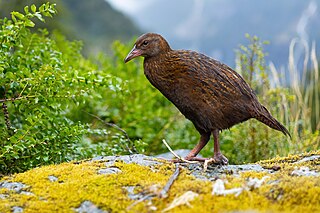
The weka, also known as the Māori hen or woodhen is a flightless bird species of the rail family. It is endemic to New Zealand. It is the only extant member of the genus Gallirallus. Four subspecies are recognized but only two (northern/southern) are supported by genetic evidence.

The South Island takahē is a flightless swamphen indigenous to New Zealand and the largest living member of the rail family. It is often known by the abbreviated name takahē, which it shares with the recently extinct North Island takahē. The two takahē species are also known as notornis.

Flightless birds are birds that, through evolution, lost the ability to fly. There are over 60 extant species, including the well-known ratites and penguins. The smallest flightless bird is the Inaccessible Island rail. The largest flightless bird, which is also the largest living bird in general, is the common ostrich.

The southern brown kiwi, tokoeka, or common kiwi is a species of kiwi from South Island, New Zealand. Until 2000 it was considered conspecific with the North Island brown kiwi, and still is by some authorities.

The great spotted kiwi, great grey kiwi or roroa is a species of kiwi endemic to the South Island of New Zealand. The great spotted kiwi, as a member of the ratites, is flightless. It is the largest of the kiwi. The rugged topography and harsh climate of the high altitude alpine part of its habitat render it inhospitable to a number of introduced mammalian predators, which include dogs, ferrets, cats, and stoats. Because of this, populations of this species have been less seriously affected by the predations of these invasive species compared to other kiwi. Nonetheless, there has been a 43% decline in population in the past 45 years, due to these predators and habitat destruction. This has led it to be classified as vulnerable. There are less than 16,000 great spotted kiwis in total, almost all in the more mountainous parts of northwest Nelson, the northwest coast, and the Southern Alps. A minority live on island reserves.

The little spotted kiwi or little grey kiwi is a small flightless bird in the kiwi family, Apterygidae. It is the smallest of the five kiwi species, at about 0.9 to 1.9 kg, about the size of a bantam. It is endemic to New Zealand, and in pre-European times occurred in both main islands, but is now restricted to a number of small offshore islands, and mainland reserves protected by pest-exclusion fences. The little spotted kiwi was on the brink of extinction when a conservation effort took place 100 years ago. Five individuals were translocated from the South Island of New Zealand to Kapiti Island. Today, the Kapiti Island population has grown, with around 1200 birds.

The Okarito kiwi, also known as the rowi or Okarito brown kiwi, is a member of the kiwi family Apterygidae, described as new to science in 2003. The species is part of the brown kiwi complex, and is morphologically very similar to other members of that complex. It is found in a restricted area of the Ōkārito forest on the West Coast of New Zealand's South Island, and has a population of only about 600 birds.
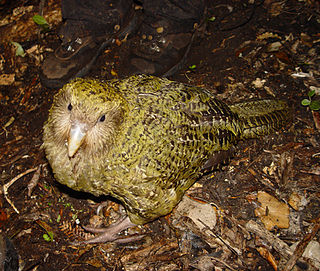
The birds of New Zealand evolved into an avifauna that included many endemic species found in no other country. As an island archipelago, New Zealand accumulated bird diversity, and when Captain James Cook arrived in the 1770s he noted that the bird song was deafening.
A. australis may refer to:

The Haast tokoeka or Haast kiwi is a putative subspecies of the southern brown kiwi. It is one of the rarest kiwi in New Zealand. Like other kiwi, this bird is flightless.
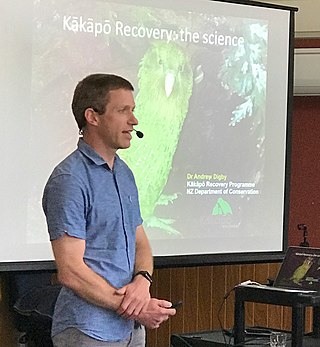
Andrew Digby is an astronomer and ecologist whose work focusses on researching and conserving New Zealand's endangered endemic birds.

The West Coast Wildlife Centre is a kiwi-rearing facility in Franz Josef, New Zealand. A public-private partnership with the Department of Conservation and Te Rūnunga o Makaawhio of Ngāi Tahu, it hatches eggs of the kiwi species rowi and Haast tokoeka retrieved from the wild. It rears the chicks until they are large enough for transfer to outdoor enclosures as part of Operation Nest Egg. More than 50 per cent of all living rowi were hatched at the Wildlife Centre. It is also a tourist attraction with several captive tuatara, museum displays, and tours of the rearing facility.

Wendi Dianne Roe is a New Zealand veterinary pathologist who specialises in researching marine mammals. She is Professor of Veterinary and Marine Mammal Pathology and Deputy Head of the School of Veterinary Science at Massey University.
Apteryx littoralis is an extinct species of kiwi from New Zealand's North Island. The species was first described in 2021 based on the holotype, a complete left tarsometatarsus that was found in the Pleistocene (Calabrian)-aged Rangitikei Formation.
The Fiordland tokoeka or Fiordland kiwi is a subspecies of southern brown kiwi. It is endemic to New Zealand. Like other ratites, it is flightless.

The Stewart Island tokoeka, Stewart Island kiwi, Rakiura tokoeka or Rakiura kiwi is a subspecies of southern brown kiwi endemic to New Zealand. Like other ratites, it is a flightless bird.
Ixodes anatis, also called the kiwi tick, is a species of tick in the arthropod family Ixodidae. It is endemic to New Zealand and mainly parasitizes kiwi.

Isabel Castro is professor of wildlife biology at Massey University in New Zealand. Her research focuses on conservation biology, primarily of birds and native ecosystems, but also including invertebrates and introduced mammals. She is a principal investigator in the Te Pūnaha Matatini Centre of Research Excellence.
